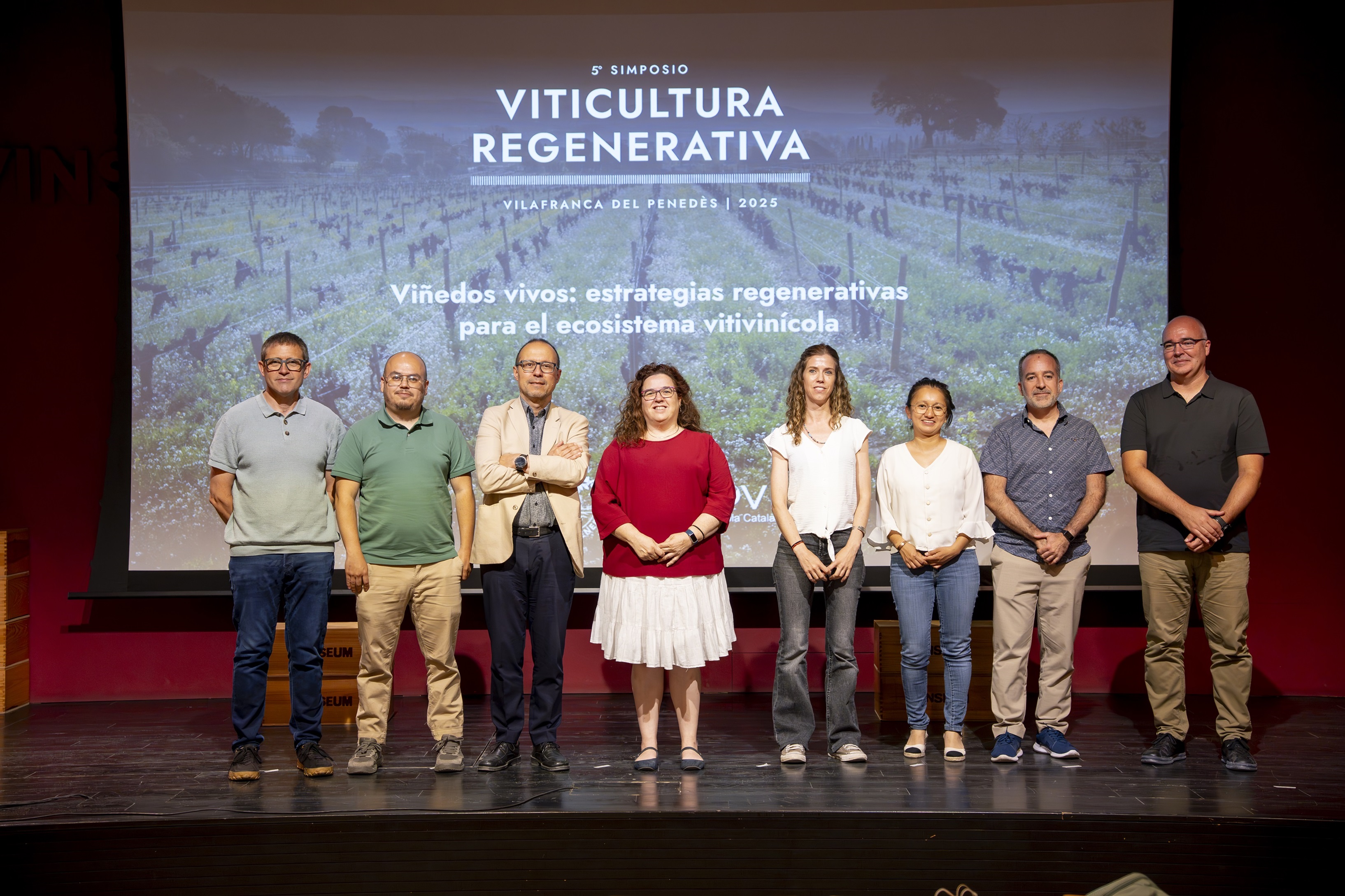The 5th Symposium on Regenerative Viticulture has brought together experts in soil management and carbon sequestration at the Vinseum in Vilafranca del Penedès to show how this sector can help curb the climate crisis. Promoted by the Association of Regenerative Viticulture and INNOVI and held on Thursday, June 12, the event has had authoritative voices to explain strategies so that the cultivation of the vine has a positive impact on the global carbon balance.
Presented by Eloi Montcada, Cluster Manager of INNOVI, the institutional welcome was given by the mayor of Vilafranca del Penedès, Francisco Romero, and the general director of INCAVI, Joan Gené, who highlighted the "vision" of launching the Symposium at the right time, a sign of " vitality and commitment of the sector". The president of INNOVI and founding member of the Association of Regenerative Viticulture, Mireia Torres, pointed out that the entity already has 125 members in almost a dozen countries. A collaborative network that promotes sustainable practices following "one of the best agricultural models and the one that makes the most sense in a context of climate change".
Being carbon negative, a unique capability
The doctor in Agronomy Luis López Bellido has launched the presentations highlighting the enormous potential of agriculture to store carbon, a capacity that makes it a unique economic sector. There is between 2 and 3 times more in the soil than in the atmosphere and vegetation, but the practices of the twentieth century have damaged this natural system and its management must be improved to recover capture capacity. The goal is for each cultivated hectare to remove between 0.8 and 4.5 tons of CO2 equivalent per year, and for this it is necessary to know the complex mechanisms that govern organic carbon. Thus, by putting science at the service of agricultural practices, the sector can be made to store more carbon than it emits.
Carbon credits, a complex issue, but with potential
The head of the Cross-Cutting Policies and External Action Service of the Department of Agriculture and former director of the Office of Climate Change, Salvador Samitier, has addressed a very important aspect of action against climate change: carbon credits, a "trading system" that can be useful in the face of the crisis but is highly complex.
A carbon credit is defined as 1 ton of CO2 equivalent. However, not all of them are the same, neither because of how they have been generated – reduction, absorption, etc. – nor because of how they have been certified – with more than 90 accepted but not harmonised methodologies – nor because of their geographical origin – the physicochemical mechanisms for carbon capture are not the same everywhere. In addition, there are two large disconnected markets, at least for the time being: that of credits obtained for compliance with regulations and that of those obtained for voluntary internships.
Standardization, the key to the carbon credits of the future
As Samitier, biologist Carlos Alberto Torres and agronomist Diana Jiménez, from the BETA centre of the University of Vic, have remarked, unified mechanisms are necessary to avoid double counting of credits, equivalent certifications and guarantee both the profitability of the credits and their durability over time. In addition, it must also be ensured that they are not generated by damaging other aspects of the environment or by violating labour and human rights.
With increasingly active financial actors and a growing demand for natural loans – forests and agriculture – this is especially important. Regenerative agriculture has advantages in the supply chain and the soil: it directly reduces the carbon footprint, strengthens the relationship with suppliers, improves the image and builds customer loyalty, complies with regulations, gives a competitive advantage and can generate credits and therefore extra income. To take advantage of this opportunity, BETA is researching how to increase soil fertility, quantify stored carbon, promote standardization and create a clear and reliable framework for the carbon credit market of the future.
Restoring soils will give us healthier and more resistant crops
The last part of the Symposium focused on soil and the mechanisms to regenerate it. The techniques and objectives are shared: reduce tillage, avoid pesticides, integrate livestock farming into crops and increase the presence of carbon in the soil, restore the biological cycle of nutrients and improve water percolation. In addition to the idea, which has flown over all the presentations, of One Health: the health of microorganisms is the basis of a chain that benefits plants, animals and humans.
Microbiologist Isabella Tomasi opened the block by announcing a new technique that represents "very interesting qualitative leaps" in root and plant health based on the pH / redox potential balance of the soil.
Breathing oxidizes, also in the case of plants. But oxidation can be reduced – and with it, the effects of physiological stress – if the plant receives more solar energy and if the soil around it maintains a proper balance between pH and redox potential. A slightly alkaline neutral pH (between 7.2 and 7.5) and a reduced redox potential (between 430 and 450 mV in the soil) are the ideal conditions to promote a resilient and active plant physiology. This combination promotes beneficial microbiological activity, stimulates the synthesis of organic compounds and strengthens the plant's defenses.
Soils with these characteristics also contain more trace elements, enzymes, vitamins and natural antioxidants, which not only contribute to the vitality of the vineyard, but can also reduce carbon emissions from plants. Tomasi is committed to the use of lacto-fermented biostimulants or compounds rich in organic matter, as tools to correct imbalances and stimulate the activity of the microbiota.
Ongoing studies
IRTA researcher Amaia Nogales spoke about the role of mycorrhizal fungi, which establish symbiosis with the roots and provide them with nutrients and water in exchange for carbon compounds. They are fundamental in the functioning of a living system: they increase the resistance of plants to pathogens and droughts, reduce mortality after planting and replanting, give structure and stability to the soil... The mycelia of these fungi allow the development of microorganisms that help the plant: plant growth-promoting bacteria, organic matter decomposers, nitrogen fixers or beneficial fungi. In addition, they stop the proliferation of pathogenic fungi and allow the roots to grow longer and better.
Intensive farming practices, however, destroy these fungi and alter the biological cycles of the soil. That is why Nogales has presented the first results of an ongoing study on the inoculation of fungi and the combination with plant covers to improve the mycorrhizal sphere, among which the increase in the presence of beneficial fungi stands out. A work that is complemented by Regenera.cat, a CREAF project that has been explained by Xavier Domene. In this case, it is aimed at improving soil biodiversity in a more general way, both on the surface and inside: pest predators, pollinators... This should also apply to adjacent habitats, benefiting crops as part of a large ecosystem.
A manual of good practices
Dr. Marc Viñas and Dr. Felicidad de Herralde, from IRTA, closed the Symposium by talking about Vitiregenere, a project in which Familia Torres has participated and which evaluates and assesses the application of regenerative viticulture with physicochemical parameters and soil microbial diversity. Initial findings show positive trends in several indicators, including carbon sequestration capacity. It will be necessary, however, more time to see its scope and also how the specific conditions of each soil condition the effectiveness of each technique.
As a first step, they have presented a manual of good practices that is already available and contains indications for those who want to orient their agricultural activity to this more sustainable model and that promotes soil regeneration and carbon sequestration.



